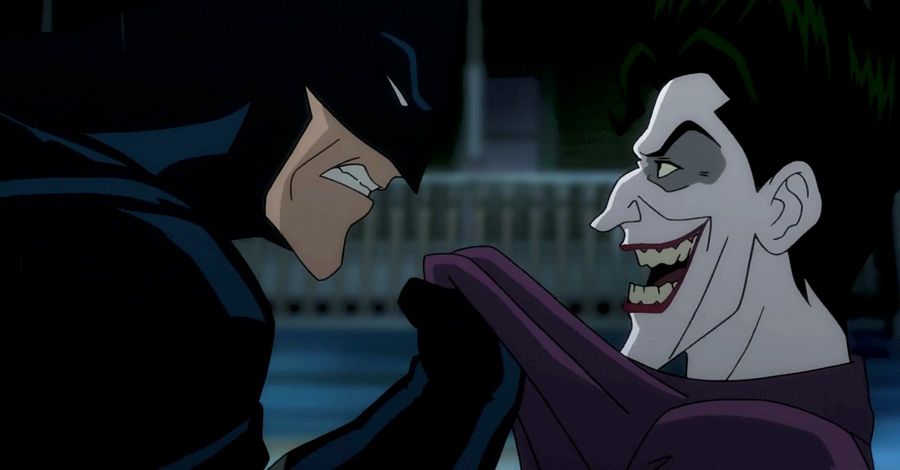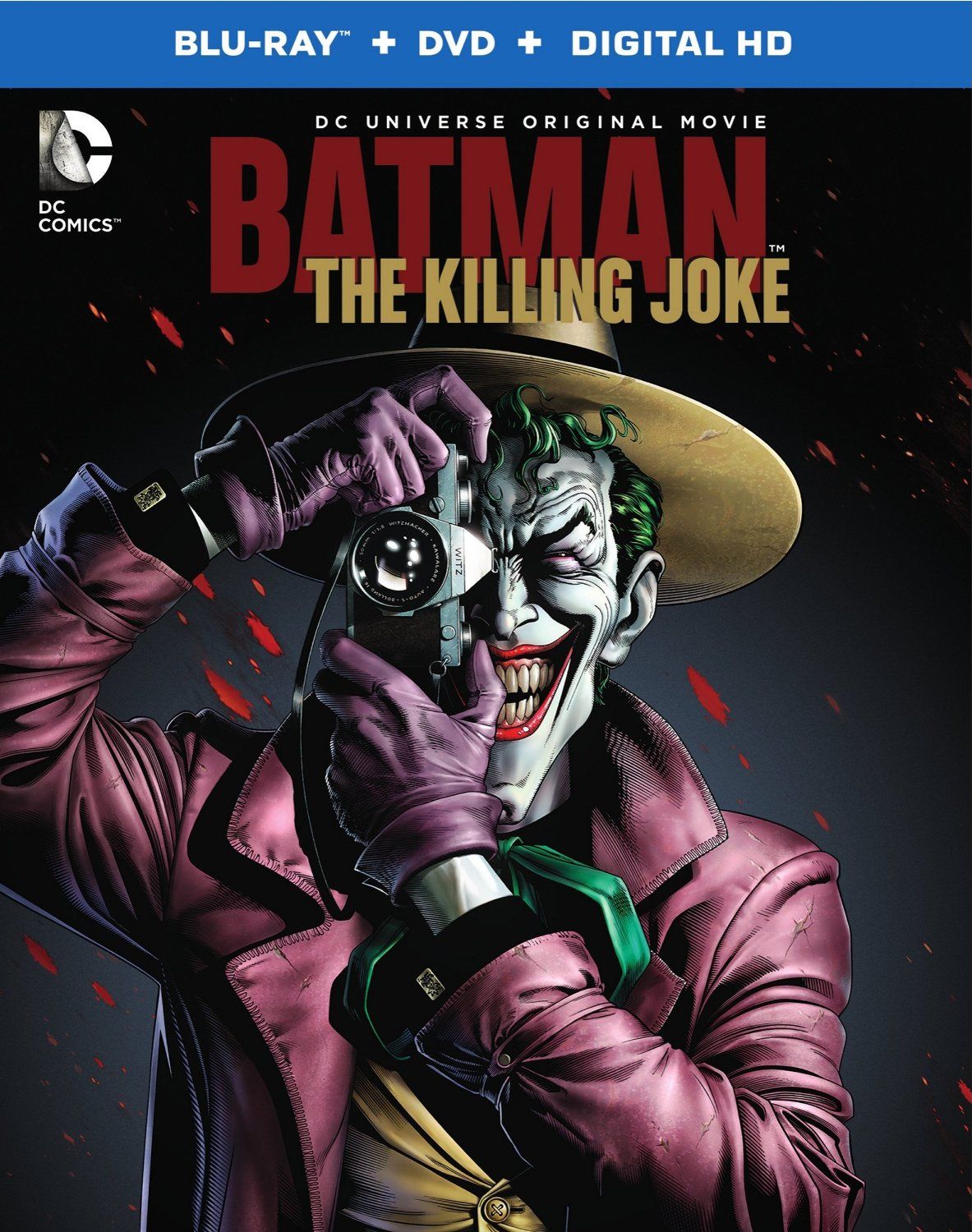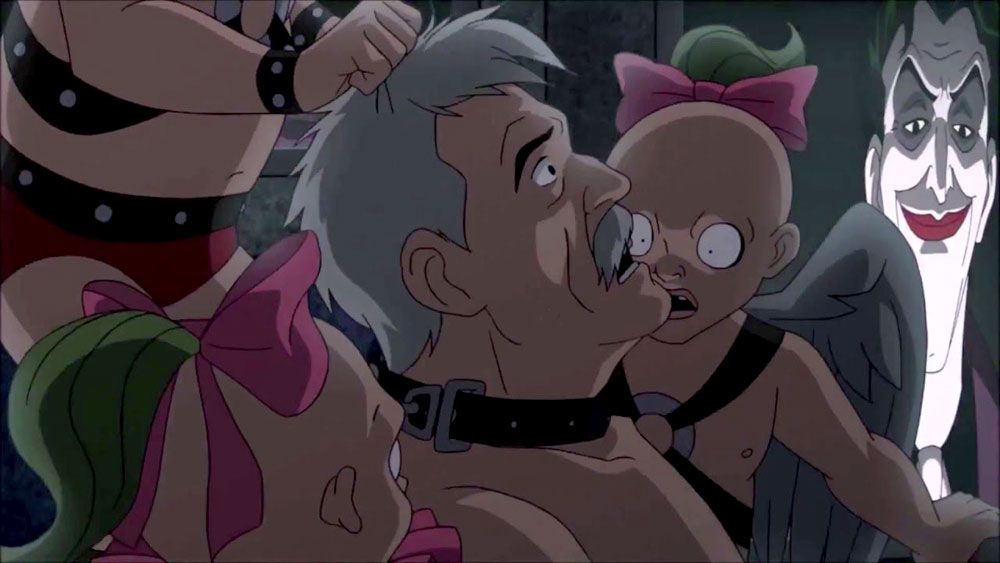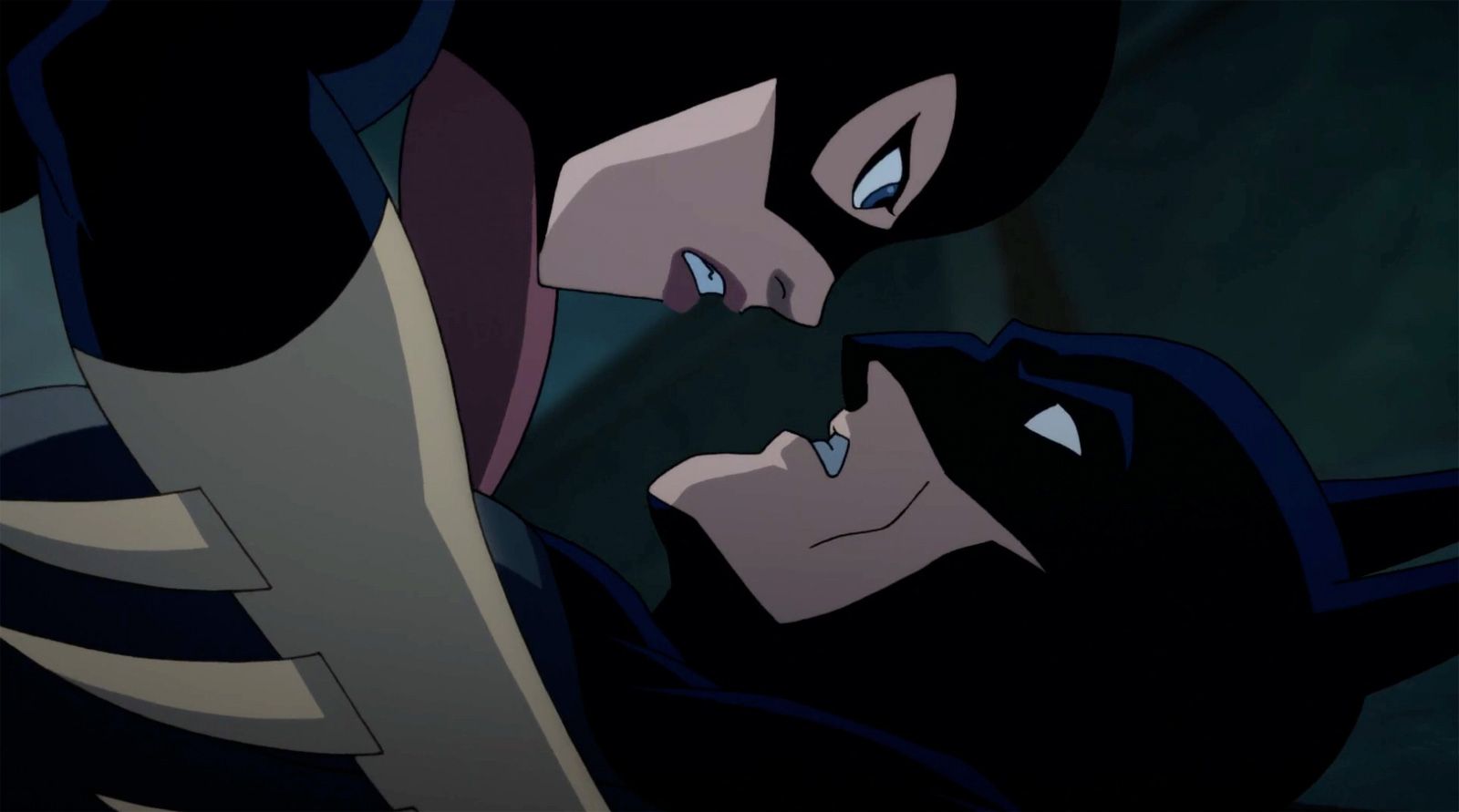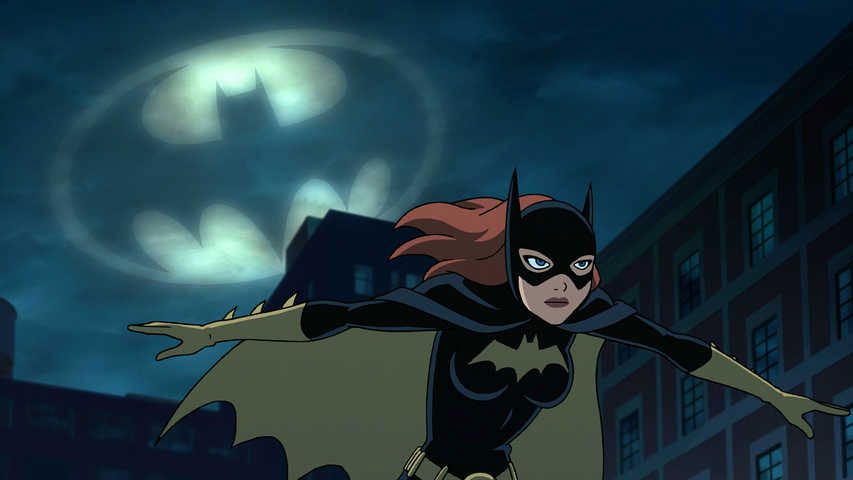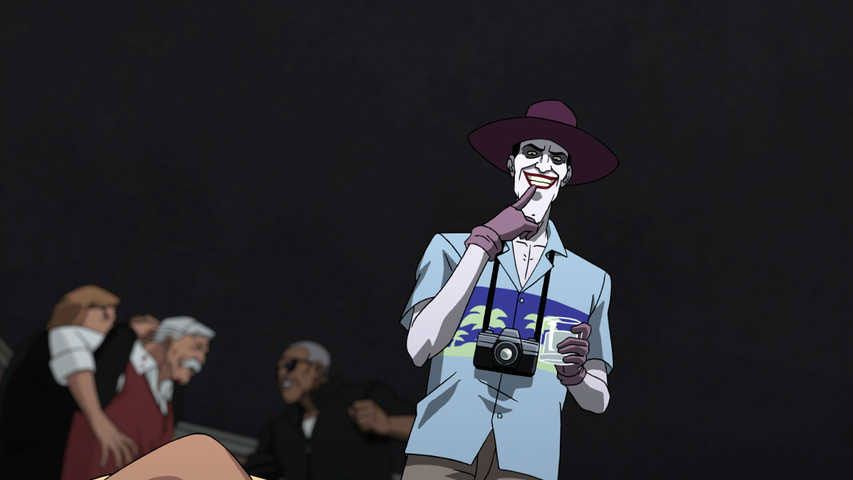SPOILER WARNING: The following review contains major spoilers for "Batman: The Killing Joke," on sale now via digital download.
If you were to rely solely on YouTube clips to get an idea of what kind of movie "Batman: The Killing Joke" is, you would rightfully come to the conclusion that it's a faithful retelling of the classic graphic novel, albeit with some odd decisions regarding Batman and Batgirl's relationship.
However, you'd only be seeing clips of half the movie. Literally. The first half of the movie is an entirely original storyline that has nothing to do with the Joker, and very little to do with Batman, for that matter.
RELATED: SDCC: "Batman: The Killing Joke" Screenwriter Explains Controversial Sex Scene
Alan Moore and Brian Bolland's "The Killing Joke" is considered the seminal, bedrock story of the yin and yang relationship of the Dark Knight and the Clown Prince of Crime. Published by DC Comics in 1988, the graphic novel utterly reshaped what a Batman story could be -- hell, it showed us what a superhero story could be. "Killing Joke" redefined the hero and villain as two sides of the same dark coin, forcing readers to recognize that Batman wasn't a mere good guy -- he was the guy who stood against the maelstrom, refusing to succumb out of sheer force of will. And, we saw that there was little separating Batman and the Joker, aside from one bad day.
Its reputation as one of the forefathers of modern superhero storytelling cannot be overstated. However, with societal shifts over the past three decades, parts of "The Killing Joke" don't hold up, with Batgirl's sexual violation and treatment as a "woman in a refrigerator" -- a term used to describe when a female character exists solely to suffer in order provide a male character motivation -- chief among them.
This storytelling device isn't limited to comics and has existed nearly as long as storytelling has. Helen's kidnapping at the hands of Paris led to the Trojan War; St. George saved an unnamed princess from the dragon at the spring; and James Bond has been motivated by more dead women than there have been Green Lanterns. But those examples all come from less-enlightened eras; this oft-repeated mechanic has come to be considered lazy and/or sexist writing. To be fair, the trope has grown to include other variations on the theme: men, children, or families can also be metaphorically shoved in refrigerators solely to further the plot of both male and female characters alike. Even when genders are flipped, the mechanic is often shallow, and devalues the stories that could have been told in its place.
So yes -- while "The Killing Joke" graphic novel is a staple of superhero storytelling, it uses the Women In Refrigerators trope to further along the story arc of the protagonist, Batman. In making the animated adaptation, the filmmakers were acutely aware of this critique, and attempted to rectify it for the modern age.
They failed. They did try, but they failed in some egregious ways.
On the surface, "The Killing Joke" is a story about the Joker and Commissioner Jim Gordon. The point of the tale is to highlight the subtle difference between the Joker and Batman, but in its telling, it's about Gordon's utterly unflinching character and the Joker's attempt to break him. It's Christopher Nolan's "The Dark Knight," twenty years prior.
The Joker breaks free from Arkham Asylum and sets in motion his latest scheme. However, this one's not about banks or mass murder -- he's got something far more personal in mind. While Jim is visiting with his daughter, Barbara, the Joker shows up. He shoots Barbara in her stomach, paralyzing her, and kidnaps Jim.
He brings the commissioner to an abandoned carnival he's outfitted with all manor of insanities: a demented side show, a twisted house of mirrors, and a funhouse through the depths of insanity. He strips Gordon naked, and has him led about on a leash by his minions, repeating his refrain over and over: When life doesn't make sense, stop trying to force it. Go mad instead.
The Joker's point is that all that separates normal people from sheer madness is "one bad day." After he has spent the night softening up the Commissioner's mind with freaks, jeers, and utter sensory shock, he brings it all home with his coup de grace: a funhouse ride featuring pictures of the brutal maiming, sexual molestation, and implied rape of Barbara, Jim's daughter. It's enough to drive any man mad, but Gordon knows the stakes, and who he's dealing with. He refuses to give in, and when Batman finally arrives to put a stop to it, he insists the Dark Knight does it "by the book." The Joker's ride into madness didn't work.
The two opponents battle, but after Batman's inevitable victory, he stops short of beating the Joker silly. He offers a hand of sympathy instead, hoping that understanding and compassion can win where fists and righteous fury have long since failed. Joker sadly refuses, admitting it's too late for either of them; they're locked into this for eternity, like two mental patients who can't even trust each other's mutual madness.
The previous text is, in short, the story of "The Killing Joke." The film does an excellent job of highlighting the difference between people like Jim Gordon and the Batman, and people like the Joker. But, in the decades since the graphic novel's release, certain aspects have not aged well; most notably, the sexual assault and victimization of the only female character in the book.
RELATED: Bruce Timm on Origins of 'Risky' Batman-Batgirl Sex Scene in "The Killing Joke"
The filmmakers attempted to adapt the story for a more modern age, but had huge missteps. Fans said, "Barbara Gordon is in this story only to suffer and further the story arcs of male characters," and they appear to have heard, "Barbara Gordon doesn't do enough stuff with the male characters."
Which kind of misses the point.
The problem with the original telling of "The Killing Joke" was how Barbara Gordon was handled. She had no agency of her own whatsoever, existing solely in relation to men. She was something for them to protect and avenge, as opposed to a fleshed-out character with her own motivations and drive.
Director Sam Liu, screenwriter Brian Azzarello and Executive Producer Bruce Timm's way of addressing this was to give Barbara Gordon her own, separate Batgirl story at the start of the film, which was an honest, pleasant surprise. The movie opens with Batgirl getting involved in a pretty standard (for Gotham) crime family story, as a mafioso heir attempts a coup against his crime boss uncle. The heir becomes obsessed with her, Batman cautions her against being involved and eventually cuts her out of the investigation, and then they have sex.
Yeah. Batman and Batgirl have sex. It's creepy, super-forced, and chockablock full of male gazey goofiness. And it's not the only part that weirdly sexualizes Barbara; at one point, as she's out for a run, the camera pans up her legs to her butt and breasts, then cuts away before it even shows her face.
Up until this moment, the mafioso story is a very good Batgirl story. It shows the dangers of treating vigilantism as a game, what happens when one lets a case get too personal, and the very hard process of realizing when one is in over one's head.
The sex scene itself is a great scene as well... up until the sex. Batman chastises Batgirl and attempts to take her off the case, which she furiously rejects. Her anger erupts in violence at Batman, which he takes. It's an expertly-told story of a student refusing to accept their place as an inferior to their teacher any longer, and the teacher allowing the student to vent as she needs to.
And then... and then they have sex. God, it's so weird.
The first half of the film served to establish three things:
1) Batman's position as the man on the edge of the abyss. He chastises Batgirl for treating the job like a game, and says she hasn't been to "the edge" yet.
2) Batman's attachment and affection for Barbara. This is supposed to make his reaction to her attack in the second half all the more personal, but his relationship to her as an uncle, or even secondary father figure, was already deeply intimate in its own way.
3) Barbara's realization that the edge of the abyss isn't for her. After they finally catch the mafioso heir, she beats him within an inch of his life and freaks herself out. She hangs up the cowl soon after.
In attempting to give Batgirl more motivation and depth (and almost pulling it off!) the filmmakers took away her power, and set her up as a romantic interest of a male protagonist.
It's a testament to the story told in the first half of the movie that in the middle of it, I started speculating about how this would tie into the story of "The Killing Joke." Perhaps, with this new, Barbara-centric storyline, they'd warp the initial storyline and have the Joker maim her father and attempt to break Barbara instead, which would have been an incredible inversion of the power dynamic.
RELATED: Bruce Timm Weighs In On Implications Of "Killing Jokes" Sexualized Joker
But that doesn't happen. In fact, the first half doesn't affect the second half at all. Batman says Batgirl's not ready, they have sex, Batgirl freaks out on a bad guy, decides she really isn't ready, and turns in her cape and cowl. Then, the Joker turns up, maims her, and "The Killing Joke" starts. The entire first half of the movie could have simply not existed, and the second half of the movie wouldn't be different at all.
In fact, I kind of wish they told the two stories separately. The first half would have been better served if it got to breathe on its own without the crushing weight of expectations for "The Killing Joke."
The movie's faults don't lie solely in how they treat Barbara, either. Jim Gordon's importance in the story is drastically diminished as well. As I said earlier, "The Killing Joke" is a story about Commissioner Gordon and the Joker that makes a point about the Batman. But in this movie, Jim Gordon is yet another victim for the Batman to avenge. He gets one line to prove that he hasn't been broken, where the entirety of his original storyline was about his mental struggle to fight off the Joker's madness.
There were very good parts of this movie, to be fair. The animation was excellent, and Kevin Conroy and Mark Hamill's voice acting were stellar, as they always have been and always shall be, amen. If you've been waiting nearly three decades to hear Hamill deliver those monologues, you will not be disappointed. He is at his best here.
Batman's character is also explored in some depth, as well. We see he is not all vengeance and growling -- a hope yet lingers that the Joker can be rehabilitated. He is still Thomas and Martha Wayne's son, after all.
"Batman: The Killing Joke" will go down as an acceptable, if disappointing, adaptation of the source material. It does a very good job of examining the nature of Batman and the Joker's relationship, but does so at the expense of every other part of the film. Conroy and Hamill are (as always) the best part, and the animation is excellent.
Unfortunately, DC Animation couldn't figure out how to keep women out of refrigerators.
"Batman: The Killing Joke" is available now on digital download; it arrives on Blu-ray August 2.

